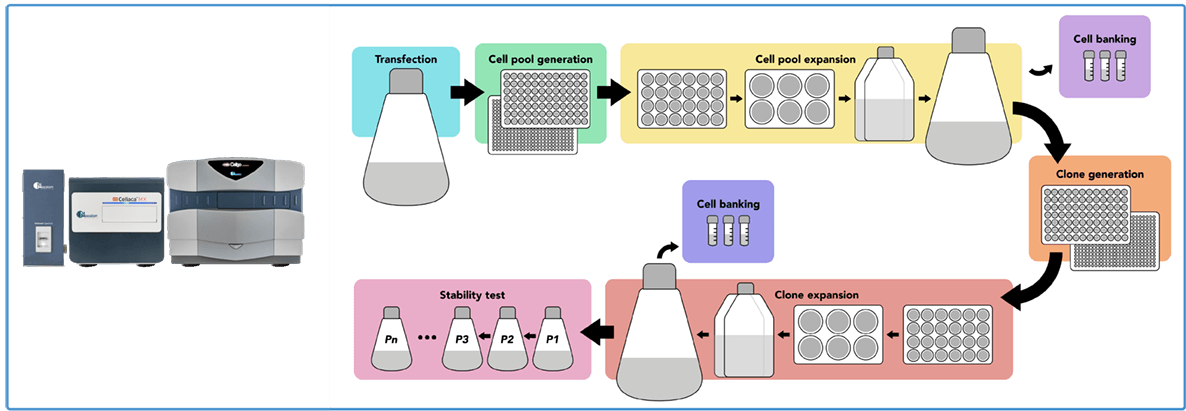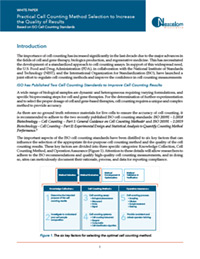Modern Cell-based Assays for Bioprocessing
Nexcelom high-throughput platforms can rapidly quantify cell concentration and viability, as well as cell-based assays to streamline every step in the bioprocessing pipeline from engineering host cells to biological protein production.

The three main types of therapy are:
- Biologic protein-based therapy with monoclonal antibodies (mAbs)
- Gene therapy (e.g., Luxturna)
- Cell therapy (e.g., ex vivo CAR-T cell-based therapies like Kymriah and Yescarta)
Biologic production relies on accurate measurements of total cell concentration and viability at every step to ensure cell survival and effective mAb production. Additional cell fitness characterization can be performed using specific fluorescent reagents such as reactive oxygen species (ROS) or caspase 3/7 apoptosis detection.
Nexcelom products utilize state-of-the-art image cytometry methods to measure total and viable cell populations, ensuring consistency and reproducibility in the bioprocessing workflow.
Optimal biologic production depends on:
- Engineering host cells
- Effective cell transfection
- Optimizing cell culture conditions (media, pH, confluence)
- Minimizing variation
- Developing assays to monitor growth and scale-up biologic production
- Monoclonality verification
Historical Perspective
The first mAb was created in 1975 after the fusion of a mouse B lymphocyte with a murine myeloma cell; these hybridomas were able to continuously secrete large quantities of antibodies [Joubert et al. 2019]. The 1970s also saw the production of the first genetically engineered human insulin by Escherichia coli.
In 1987, Chinese Hamster Ovary (CHO) cells were introduced to produce mAb, which was a major advancement in mAb manufacturing. This system was used to produce tissue plasminogen activator in 1987, followed by erythropoietin two years later. In the 1990s, the first chimeric recombinant and humanized antibodies were established [Joubert et al. 2019].
Currently, more than half of the available commercial mAbs are made in CHO cells. They offer the advantages of being robust, genetically manipulable, and possessing a strong track record with regulatory authorities.
They can be modified to:
- Improve cell growth
- Minimize apoptosis
- Optimize metabolism
- Promote protein product secretion
Mammalian cells provide the additional benefit of similarity with human glycosylation and other post-translational modifications (PTMs) [Dalton and Barton, 2014]. Approximately 70% of biopharmaceuticals are based on mammalian cell culture processes, which can bottleneck their production due to limits on cultivation time, growth capacity, and product yield [Fischer et al., 2015].
Despite these challenges, mAbs have become one of the most widely used therapeutic classes. They currently account for half of the ten best-selling drugs and $50 billion in sales annually [Baeshen et al. 2014]. While antibody-based drugs are an important tool in the armamentarium against hundreds of medical conditions, several critical biomanufacturing issues are obstacles in the industry, including protein expression platform productivity [Joubert et al. 2020].
This resource will discuss obstacles in the in vitro production of therapeutic proteins including:
- Engineering CHO cells with CRISPR
- Transfecting cell lines
- Selecting media
- Monitoring growth and viability
- Single-cell cloning
- Clone selection
Each of these critical steps relies on accurate measurements of cell concentration and viability. Counting viable cells is necessary for downstream assays of productivity (antibody titer, enzyme activity levels, etc.).
Modern Cell-based Assays for Bioprocessing
Current technologies for optimizing bioprocessing workflow
During early-stage research, it is important to define and optimize a reproducible manufacturing process with an established characterization profile to support product release and development.
Efficient production relies on three key checkpoints:
- Total and viable cell concentrations
- Cell viability
- Protein productivity and quality
The first two indicators are critical factors to optimize cell seeding, selecting the best feeding strategy, and timing harvesting. All three variables contribute to both protein productivity and quality in each step of the biologics development process.
Image cytometry assays improve speed and efficiency for cell counting assays
Current challenges for cell count and viability measurements for bioprocessing workflow are obtaining consistent readouts, cell counting accuracy, and the amount of time required to measure large amounts of samples.
Nexcelom has also been participating in the creation of the ISO Cell Counting Standards series and continues to provide support and practical procedures as well as protocols to practice ISO Cell Counting Standards2, 13.
Image cytometry and automated cell counting systems modernize the cell counting and analysis workflow2, 13
- Improve precision, robustness, and accuracy
- Provide high-throughput analysis
Nexcelom image cytometry and cell counting systems can support many aspects of biologics research and development by providing rapid, user-friendly solutions for
- Cell counting and viability
- Measuring transduction efficiency
- Cell proliferation analysis
- Functional cell cytotoxicity assays
- Apoptosis analysis
Overall benefits of employing image cytometry for cell counting and cell-based assays
- Perform label-free cell proliferation assays in 96- and 384-well plates at 5 min per plate
- Direct cell counting to determine expression levels from 6- to 1536-well plates
- High speed, high-throughput, whole-well imaging for quality control of cell-based assays
- Cell-based antibody binding assays in 96-well plates in 15 min with 4 fluorescent colors
- High-throughput cell counter provides precise cell count and viability for 24 samples in <3 min
- CFR 21 Part 11 Software Modules for regulatory conformation
Nexcelom platforms enable development and functional assays to support biologic development and production
Fully evaluated systems following ISO Cell Counting Standards
- Viable Cell Concentration
- Total Cell Concentration
- Viability measurement
- Brightfield Only – Brightfield and Trypan Blue
- Brightfield and Fluorescence – Brightfield and Propidium Iodide
- Fluorescence-based method – Brightfield, Acridine Orange and Propidium Iodide
Developmental cell-based assays:
- Proliferation
- Apoptosis
- Cell cycle
- Fluorescence protein expression
- Single-cell monoclonality

